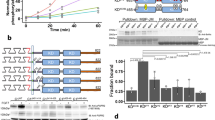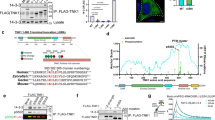Abstract
Post-translational sumoylation, the covalent attachment of a small ubiquitin-like modifier (SUMO), regulates the functions of proteins engaged in diverse processes. Often associated with nuclear and perinuclear proteins, such as transcription factors, it is not known whether SUMO can conjugate to cell-surface receptors for growth factors to regulate their functions. Here we show that the type I transforming growth factor-β (TGF-β) receptor, TβRI, is sumoylated in response to TGF-β and that its sumoylation requires the kinase activities of both TβRI and the type II TGF-β receptor, TβRII. Sumoylation of TβRI enhances receptor function by facilitating the recruitment and phosphorylation of Smad3, consequently regulating TGF-β-induced transcription and growth inhibition. TβRI sumoylation modulates the dissemination of transformed cells in a mouse model of TβRI-stimulated metastasis. TβRI sumoylation therefore controls responsiveness to TGF-β, with implications for tumour progression. Sumoylation of cell-surface receptors may regulate other growth factor responses.
This is a preview of subscription content, access via your institution
Access options
Subscribe to this journal
Receive 12 print issues and online access
$209.00 per year
only $17.42 per issue
Buy this article
- Purchase on Springer Link
- Instant access to full article PDF
Prices may be subject to local taxes which are calculated during checkout






Similar content being viewed by others
References
Feng, X. H. & Derynck, R. Specificity and versatility in TGF-β signaling through Smads. Annu. Rev. Cell Dev. Biol. 21, 659–693 (2005).
Massagué, J., Seoane, J. & Wotton, D. Smad transcription factors. Genes Dev. 19, 2783–2810 (2005).
Izzi, L. & Attisano, L. Ubiquitin-dependent regulation of TGFβ signaling in cancer. Neoplasia 8, 677–688 (2006).
Kavsak, P. et al. Smad7 binds to Smurf2 to form an E3 ubiquitin ligase that targets the TGFβ receptor for degradation. Mol. Cell 6, 1365–1375 (2000).
Ebisawa, T. et al. Smurf1 interacts with transforming growth factor-β type I receptor through Smad7 and induces receptor degradation. J. Biol. Chem. 276, 12477–12480 (2001).
Kuratomi, G. et al. NEDD4-2 (neural precursor cell expressed, developmentally down-regulated 4-2) negatively regulates TGF-β (transforming growth factor-β) signalling by inducing ubiquitin-mediated degradation of Smad2 and TGF-β type I receptor. Biochem. J. 386, 461–470 (2005).
Komuro, A. et al. Negative regulation of transforming growth factor-β (TGF-β) signaling by WW domain-containing protein 1 (WWP1). Oncogene 23, 6914–6923 (2004).
Wieser, R., Wrana, J. L. & Massagué, J. GS domain mutations that constitutively activate TβR-I, the downstream signaling component in the TGF-β receptor complex. EMBO J. 14, 2199–2208 (1995).
Feng, X. H. & Derynck, R. Ligand-independent activation of transforming growth factor (TGF) β signaling pathways by heteromeric cytoplasmic domains of TGF-β receptors. J. Biol. Chem. 271, 13123–13129 (1996).
Johnson, E. S. Protein modification by SUMO. Annu. Rev. Biochem. 73, 355–382 (2004).
Goto, D. et al. A single missense mutant of Smad3 inhibits activation of both Smad2 and Smad3, and has a dominant negative effect on TGF-β signals. FEBS Lett. 430, 201–204 (1998).
Larsson, J. et al. Abnormal angiogenesis but intact hematopoietic potential in TGF-β type I receptor-deficient mice. EMBO J. 20, 1663–1673 (2001).
Levy, L. & Hill, C. S. Alterations in components of the TGF-β superfamily signaling pathways in human cancer. Cytokine Growth Factor Rev. 17, 41–58 (2006).
Derynck, R., Akhurst, R. J. & Balmain, A. TGF-β signaling in tumor suppression and cancer progression. Nature Genet. 29, 117–129 (2001).
Oft, M., Heider, K. H. & Beug, H. TGFβ signaling is necessary for carcinoma cell invasiveness and metastasis. Curr. Biol. 8, 1243–1252 (1998).
Oft, M., Akhurst, R. J. & Balmain, A. Metastasis is driven by sequential elevation of H-ras and Smad2 levels. Nature Cell Biol. 4, 487–494 (2002).
Chen, T., Carter, D., Garrigue-Antar, L. & Reiss, M. Transforming growth factor β type I receptor kinase mutant associated with metastatic breast cancer. Cancer Res. 58, 4805–4810 (1998).
Chen, T. et al. Novel inactivating mutations of transforming growth factor-β type I receptor gene in head-and-neck cancer metastases. Int. J. Cancer 93, 653–661 (2001).
Rajan, S., Plant, L. D., Rabin, M. L., Butler, M. H. & Goldstein, S. A. Sumoylation silences the plasma membrane leak K+ channel K2P1. Cell 121, 37–47 (2005).
Benson, M. D. et al. SUMO modification regulates inactivation of the voltage-gated potassium channel Kv1.5. Proc. Natl Acad. Sci. USA 104, 1805–1810 (2007).
Martin, S., Nishimune, A., Mellor, J. R. & Henley, J. M. SUMOylation regulates kainate-receptor-mediated synaptic transmission. Nature 447, 321–325 (2007).
Li, B., Carey, M. & Workman, J. L. The role of chromatin during transcription. Cell 128, 707–719 (2007).
Bode, A. M. & Dong, Z. Post-translational modification of p53 in tumorigenesis. Nature Rev. Cancer 4, 793–805 (2004).
Grönroos, E., Hellman, U., Heldin, C. H. & Ericsson, J. Control of Smad7 stability by competition between acetylation and ubiquitination. Mol. Cell 10, 483–493 (2002).
Hietakangas, V. et al. PDSM, a motif for phosphorylation-dependent SUMO modification. Proc. Natl Acad. Sci. USA 103, 45–50 (2006).
Rodriguez, M. S. et al. SUMO-1 modification activates the transcriptional response of p53. EMBO J. 18, 6455–6461 (1999).
Buschmann, T., Fuchs, S. Y., Lee, C. G., Pan, Z. Q. & Ronai, Z. SUMO-1 modification of Mdm2 prevents its self-ubiquitylation and increases Mdm2 ability to ubiquitinate p53. Cell 101, 753–762 (2000).
Schmidt, D. & Müller, S. Members of the PIAS family act as SUMO ligases for c-Jun and p53 and repress p53 activity. Proc. Natl Acad. Sci. USA 99, 2872–2877 (2002).
Bies, J., Markus, J. & Wolff, L. Covalent attachment of the SUMO-1 protein to the negative regulatory domain of the c-Myb transcription factor modifies its stability and transactivation capacity. J. Biol. Chem. 277, 8999–9009 (2002).
Kim, J. H. et al. Roles of sumoylation of a reptin chromatin-remodelling complex in cancer metastasis. Nature Cell Biol. 8, 631–639 (2006).
Dore, J. J. Jr et al. Mechanisms of transforming growth factor-β receptor endocytosis and intracellular sorting differ between fibroblasts and epithelial cells. Mol. Biol. Cell 12, 675–684 (2001).
Greenman, C. et al. Patterns of somatic mutation in human cancer genomes. Nature 446, 153–158 (2007).
Lee, P. S., Chang, C., Liu, D. & Derynck, R. Sumoylation of Smad4, the common Smad mediator of transforming growth factor-β family signaling. J. Biol. Chem. 278, 27853–27863 (2003).
Feng, X. H., Filvaroff, E. H. & Derynck, R. Transforming growth factor-β (TGF-β)-induced down-regulation of cyclin A expression requires a functional TGF-β receptor complex. Characterization of chimeric and truncated type I and type II receptors. J. Biol. Chem. 270, 24237–24245 (1995).
Miller, A. D. & Rosman, G. J. Improved retroviral vectors for gene transfer and expression. Biotechniques 7, 980–982, 984–986, 989–990 (1989).
Johnson, R., Spiegelman, B., Hanahan, D. & Wisdom, R. Cellular transformation and malignancy induced by ras require c-jun. Mol. Cell. Biol. 16, 4504–4511 (1996).
ten Dijke, P. et al. Activin receptor-like kinases: a novel subclass of cell-surface receptors with predicted serine/threonine kinase activity. Oncogene 8, 2879–2887 (1993).
ten Dijke, P. et al. Characterization of type I receptors for transforming growth factor-β and activin. Science 264, 101–104 (1994).
Feng, X. H., Zhang, Y., Wu, R. Y. & Derynck, R. The tumor suppressor Smad4/DPC4 and transcriptional adaptor CBP/p300 are coactivators for Smad3 in TGF-β-induced transcriptional activation. Genes Dev. 12, 2153–2163 (1998).
Graycar, J. L. et al. Human transforming growth factor-β3: recombinant expression, purification, and biological activities in comparison with transforming growth factors-β1 and -β2. Mol. Endocrinol. 3, 1977–1986 (1989).
Dennler, S. et al. Direct binding of Smad3 and Smad4 to critical TGFβ-inducible elements in the promoter of human plasminogen activator inhibitor-type 1 gene. EMBO J. 17, 3091–3100 (1998).
Kang, J. S., Alliston, T., Delston, R. & Derynck, R. Repression of Runx2 function by TGF-β through recruitment of class II histone deacetylases by Smad3. EMBO J. 24, 2543–2555 (2005).
Choy, L., Skillington, J. & Derynck, R. Roles of autocrine TGF-β receptor and Smad signaling in adipocyte differentiation. J. Cell Biol. 149, 667–682 (2000).
Acknowledgements
This research was supported by grants RO1-CA63101 and R21-CA125190 to R.D. and PO1 AR050440 and RO1s CA116019 and HL078564 to R.J.A. from the National Institutes of Health, and a Scientist Development grant 0630322N to J.S.K. from the American Heart Association.
Author information
Authors and Affiliations
Contributions
J.S.K., R.J.A. and R.D. conceived and designed the studies; J.S.K. and E.F.S. performed the experiments; J.S.K., E.F.S., R.J.A. and R.D. prepared the manuscript.
Corresponding author
Ethics declarations
Competing interests
The authors declare no competing financial interests.
Supplementary information
Supplementary Information
Supplementary Figures S1, S2, S3, S4 (PDF 568 kb)
Rights and permissions
About this article
Cite this article
Kang, J., Saunier, E., Akhurst, R. et al. The type I TGF-β receptor is covalently modified and regulated by sumoylation. Nat Cell Biol 10, 654–664 (2008). https://doi.org/10.1038/ncb1728
Received:
Accepted:
Published:
Issue Date:
DOI: https://doi.org/10.1038/ncb1728
This article is cited by
-
Circ-RAPGEF5 promotes intrahepatic cholangiocarcinoma progression by stabilizing SAE1 to facilitate SUMOylation
Journal of Experimental & Clinical Cancer Research (2023)
-
L-Fucose promotes enteric nervous system regeneration in type 1 diabetic mice by inhibiting SMAD2 signaling pathway in enteric neural precursor cells
Cell Communication and Signaling (2023)
-
Unconventional protein post-translational modifications: the helmsmen in breast cancer
Cell & Bioscience (2022)
-
TGF-β signaling pathway mediated by deubiquitinating enzymes
Cellular and Molecular Life Sciences (2019)
-
Innate immune activating ligand SUMOylation affects tumor cell recognition by NK cells
Scientific Reports (2017)



